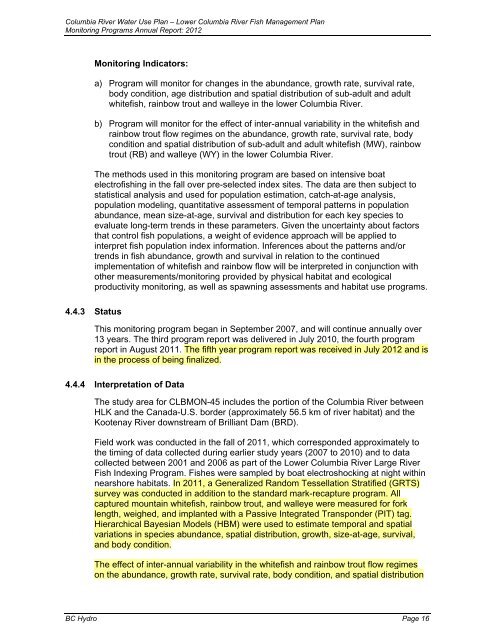August 201 - BC Hydro
August 201 - BC Hydro
August 201 - BC Hydro
You also want an ePaper? Increase the reach of your titles
YUMPU automatically turns print PDFs into web optimized ePapers that Google loves.
Columbia River Water Use Plan – Lower Columbia River Fish Management Plan<br />
Monitoring Programs Annual Report: <strong>201</strong>2<br />
Monitoring Indicators:<br />
a) Program will monitor for changes in the abundance, growth rate, survival rate,<br />
body condition, age distribution and spatial distribution of sub-adult and adult<br />
whitefish, rainbow trout and walleye in the lower Columbia River.<br />
b) Program will monitor for the effect of inter-annual variability in the whitefish and<br />
rainbow trout flow regimes on the abundance, growth rate, survival rate, body<br />
condition and spatial distribution of sub-adult and adult whitefish (MW), rainbow<br />
trout (RB) and walleye (WY) in the lower Columbia River.<br />
The methods used in this monitoring program are based on intensive boat<br />
electrofishing in the fall over pre-selected index sites. The data are then subject to<br />
statistical analysis and used for population estimation, catch-at-age analysis,<br />
population modeling, quantitative assessment of temporal patterns in population<br />
abundance, mean size-at-age, survival and distribution for each key species to<br />
evaluate long-term trends in these parameters. Given the uncertainty about factors<br />
that control fish populations, a weight of evidence approach will be applied to<br />
interpret fish population index information. Inferences about the patterns and/or<br />
trends in fish abundance, growth and survival in relation to the continued<br />
implementation of whitefish and rainbow flow will be interpreted in conjunction with<br />
other measurements/monitoring provided by physical habitat and ecological<br />
productivity monitoring, as well as spawning assessments and habitat use programs.<br />
4.4.3 Status<br />
This monitoring program began in September 2007, and will continue annually over<br />
13 years. The third program report was delivered in July <strong>201</strong>0, the fourth program<br />
report in <strong>August</strong> <strong>201</strong>1. The fifth year program report was received in July <strong>201</strong>2 and is<br />
in the process of being finalized.<br />
4.4.4 Interpretation of Data<br />
The study area for CLBMON-45 includes the portion of the Columbia River between<br />
HLK and the Canada-U.S. border (approximately 56.5 km of river habitat) and the<br />
Kootenay River downstream of Brilliant Dam (BRD).<br />
Field work was conducted in the fall of <strong>201</strong>1, which corresponded approximately to<br />
the timing of data collected during earlier study years (2007 to <strong>201</strong>0) and to data<br />
collected between 2001 and 2006 as part of the Lower Columbia River Large River<br />
Fish Indexing Program. Fishes were sampled by boat electroshocking at night within<br />
nearshore habitats. In <strong>201</strong>1, a Generalized Random Tessellation Stratified (GRTS)<br />
survey was conducted in addition to the standard mark-recapture program. All<br />
captured mountain whitefish, rainbow trout, and walleye were measured for fork<br />
length, weighed, and implanted with a Passive Integrated Transponder (PIT) tag.<br />
Hierarchical Bayesian Models (HBM) were used to estimate temporal and spatial<br />
variations in species abundance, spatial distribution, growth, size-at-age, survival,<br />
and body condition.<br />
The effect of inter-annual variability in the whitefish and rainbow trout flow regimes<br />
on the abundance, growth rate, survival rate, body condition, and spatial distribution<br />
<strong>BC</strong> <strong>Hydro</strong> Page 16

















